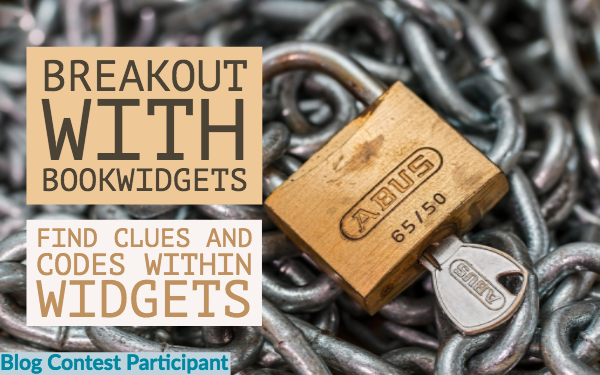Breakout with BookWidgets - On the search for clues and codes within widgets
 Brenda Gullikson —
Brenda Gullikson —
We asked BookWidgets users to submit their stories about using BookWidgets in their classroom. This post is one of these stories. Click here to vote on this post.
My students enjoy the problem solving activity of breakout boxes. If you aren’t familiar with the concept, students solve a series of puzzles or tasks that lead them to a prize.
You can use breakout boxes to:
- introduce concepts;
- reinforce information;
- and review.
The brownie case
My favorite was using the concept to review basic cooking information such as fractions, measuring, safety, terms, etc.
Students had made brownies in a lab and were supposed to enjoy their creations during a review for a test.
Then it hit me. They were going to work to get their brownies. I created a series of puzzles that would eventually give them a key to the box that contained their brownies. The students enjoyed the process, and of course, … the brownies.
I have to admit that setting up the activities and tasks can be daunting, especially with multiple class periods in a row.
One of the first tasks that I often have students do, is to work as a team to put together a jigsaw puzzle. Each piece has a number on it. I give students coordinates for 3 numbers that correlate to the combination on a lock containing the next activity.
Problem: Over time, pieces get lost, I find them on the floor and I have to put all the puzzles together to figure out which one it belongs to, and pieces get damaged.
The questions that are constantly in the back of my mind are “How can I make this more efficient?” and “How can I be sure that this will work for several classes in a row?”.
Cue BookWidgets entrance!
There are many options in BookWidgets that can be used in the breakout box. The list below are the ideas that I came up with. I am confident that as you work through the process of setting up this learning experience for students, more ideas will occur.
For my setup, I have programmable padlocks. The goal: students have to access a 3 digit code.
Use BookWidgets to give breakout codes and clues
1. Worksheet
 Create a series of true/false questions. Make three of the questions false. Students use the question numbers that correlate with the false answers to open the next lock.
Create a series of true/false questions. Make three of the questions false. Students use the question numbers that correlate with the false answers to open the next lock.
Another option would be to use multiple choice questions that have numbers assigned to various choices.
You can use the “feedback function” as well. Here, you can give students a message (clue, code or link to a new widget) when students achieve a certain grade. In order to get the feedback, students will have to get, for example, at least 80% on the worksheet or quiz. If not, they have to keep on trying.
2. Timeline
 Create a series of events or steps in a process for students to put in order. Assign each event or step a number that will create a code. When students have put the events in the right order, the numbers will line op well and create the right code.
Create a series of events or steps in a process for students to put in order. Assign each event or step a number that will create a code. When students have put the events in the right order, the numbers will line op well and create the right code.
3. Image Carousel
 Use pictures of the classroom to act as clues for where students can go to find their next clue or the final reward. For example: the classroom sink. There, you could paste a paper with a verse on and a book title. Students have to look for the verse in the classroom library and remember the right page. This can be useful to find the end code.
Use pictures of the classroom to act as clues for where students can go to find their next clue or the final reward. For example: the classroom sink. There, you could paste a paper with a verse on and a book title. Students have to look for the verse in the classroom library and remember the right page. This can be useful to find the end code.
4. Hotspot image
 Create hidden hotspots on an image related to your content. These hotspots can be text, audio, images, video and links to other widgets. Students have to pan the image to find information that will help them solve the puzzle or go to the next clue.
Create hidden hotspots on an image related to your content. These hotspots can be text, audio, images, video and links to other widgets. Students have to pan the image to find information that will help them solve the puzzle or go to the next clue.
You can also insert a map of the school or your classroom as background image and insert hidden hotspots with clues to new clues, hidden in the classroom or school.
5. TipTiles
 Create audio and video files (upload to YouTube) to include with images that will give students instructions or give them clues. You know how it goes by now, so use your imagination!
Create audio and video files (upload to YouTube) to include with images that will give students instructions or give them clues. You know how it goes by now, so use your imagination!
Include, for example, a video of a teacher colleague held hostage with a newspaper in front of her. Students should be able to get clues out of the video that leads them to next clue. How cool would it be if, when students reach the place where your colleague is held hostage, they would really find her and could free her. That’s a true endgame!
6. Game widgets
 Many game widgets like Pair Matching, Jigsaw Puzzle, Memory game and Spot the difference have the option to put in a reward word. Create the information that you want students to access. Change the reward word to the code for the next task or to the final 3 digit code.
Many game widgets like Pair Matching, Jigsaw Puzzle, Memory game and Spot the difference have the option to put in a reward word. Create the information that you want students to access. Change the reward word to the code for the next task or to the final 3 digit code.
7. Arithmetic
 Here, you can give students a reward word when they have calculated everything right. Students get a letter or a digit everytime they are right untill they find the complete reward word. This word can be a clue to the next task. You could also enter digits as reward word letters. In the end, students have to cumulate all the digits with each other to get their first digits of the code.
Here, you can give students a reward word when they have calculated everything right. Students get a letter or a digit everytime they are right untill they find the complete reward word. This word can be a clue to the next task. You could also enter digits as reward word letters. In the end, students have to cumulate all the digits with each other to get their first digits of the code.
Google Classroom tip
Any of these activities can be assigned through Google Classroom as well. I would schedule the clues to appear at various times throughout the class period or create drafts that are sent to groups of students. Those drafts can be sent out as groups accomplish the tasks.
These are just the tip of the iceberg of how BookWidgets can be used to create or augment the breakout box experience. Let your creativity lose and create a fun breakout experience for your students. They will love it!


